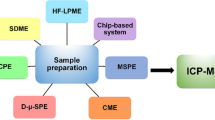Abstract
A specific procedure is proposed for investigating the chemical speciation of zinc (Zn) in plant tissues, viz., the extraction of Zn compounds from Plantago lanceolata L. followed by the chromatographic separation and inductively coupled plasma mass spectrometry (ICP-MS) identification of these compounds. In order to separate the Zn compounds, both size-exclusion (SEC) and ionexchange liquid chromatography (IC) were used in direct sequential and reverse sequential modes. In the direct sequential mode, the entire extract undergoes SEC separation and then the individual fractions are injected onto the ion-exchange column. The molecular size distribution is evaluated by SEC coupled on-line to the UV detector. In the reverse sequential mode, the entire extract undergoes the ion-exchange chromatographic separation and then the individual fractions are injected onto the size-exclusion column. The identification of Zn incorporated into the compounds is further performed using ICP-MS. This procedure is particularly useful in speciation studies when identification of the individual components of the element is problematic due to the lack of suitable standard substances, as is the case for Zn compounds. The proposed procedure facilitates assignment of the signals to the individual components of the fractions for both types of chromatography, thus rendering the chemical speciation of Zn possible when the lack of suitable standard substances impedes the identification of individual components.
Similar content being viewed by others
References
Alloway, B. J. (2008). Zinc in soils and crop nutrition (2nd ed.). Brussels, Belgium/Paris, France: IZA/IFA.
Baranowska-Morek, A. (2003). Roślinne mechanizmy tolerancji na działanie metali ciężkich. Kosmos: Problemy Nauk Biologicznych, 52, 283–298. (in Polish)
Bulska, E., Wysocka, I. A., Wierzbicka, M. H., Proost, K., Janssens, K., & Falkenberg, G. (2006). In vivo investigation of the distribution and the local speciation of selenium in Allium cepa L. by means of microscopic X-ray absorption nearedge structure spectroscopy and confocal microscopic X-ray fluorescence analysis. Analytical Chemistry, 78, 7616–7624. DOI: 10.1021/ac060380s.
Chang, S. H., Wei, Y. L., & Wang, H. P. (2007). Zinc species distribution in EDTA-extract residues of zinc-contaminated soil. Journal of Electron Spectroscopy and Related Phenomena, 156–158, 220–223. DOI: 10.1016/j.elspec.2006.12.008.
Chardonnens, A. N., Ten Bookum, W. M., Vellinga, S., Schat, H., Verkleij, J. A. C., & Ernst, W. H. O. (1999). Allocation patterns of zinc and cadmium in heavy metal tolerant and sensitive Silene vulgaris. Journal of Plant Physiology, 155, 778–787. DOI: 10.1016/s0176-1617(99)80096-0.
Chen, R., Smith, B.W., Winefordner, J. D., Tu, M. S., Kertulis, G., & Ma, L. Q. (2004). Arsenic speciation in Chinese brake fern by ion-pair high-performance liquid chromatography-inductively coupled plasma mass spectrometry. Analytica Chimica Acta, 504, 199–207. DOI: 10.1016/j.aca.2003.10.042.
Harmens, H., Gusmǎo, N. G. C. P. B., Den Hartog, P. R., Verkleij, A. J. A. C., & Ernst, W. H. O. (1993). Uptake and transport of zinc in zinc-sensitive and zinc tolerant Silene vulgaris. Journal of Plant Physiology, 141, 309–315. DOI: 10.1016/s0176-1617(11)81740-2.
Ponce de León, C. A., Montes-Bayón, M., & Caruso, J. A. (2002), Elemental speciation by chromatographic separation with inductively coupled plasma mass spectrometry detection. Journal of Chromatography A, 974, 1–21. DOI: 10.1016/s0021-9673(02)01239-6.
Sarret, G., Willems, G., Isaure, M. P., Marcus, M. A., Fakra, S. C., Frérot, H., Pairis, S., Geoffroy, N., Manceau, A., & Saumitou-Laprade, P. (2009). Zinc distribution and speciation in Arabidopsis halleri × Arabidopsis lyrata progenies presenting various zinc accumulation capacities. New Phytologist, 184, 581–595. DOI: 10.1111/j.1469-8137.2009.02996.x.
Straczek, A., Sarret, G., Manceau, A., Hinsinger, P., Geoffroy, N., & Jaillard, B. (2008). Zinc distribution and speciation in roots of various genotypes of tobacco exposed to Zn. Environmental and Experimental Botany, 63, 80–90. DOI: 10.1016/j.envexpbot.2007.10.034.
Szpunar, J., & Lobinski, R. (1999). Species-selective analysis for metal-biomacromolecular complexes using hyphenated techniques. Pure and Applied Chemistry, 71, 899–918. DOI: 10.1351/pac199971050899.
Szpunar, J., Pellerin, P., Makarov, A., Doco, T., Williams, P., & Łobiński, R. (1999). Speciation of metal-carbohydrate complexes in fruit and vegetable samples by size-exclusion HPLC-ICP-MS. Journal of Analytical Atomic Spectrometry, 14, 639–644. DOI: 10.1039/a808231f.
Vulkan, R., Mingelgrin, U., Ben-Asher, J., & Frenkel, H. (2002). Copper and zinc speciation in the solution of a soil-sludge mixture. Journal of Environmental Quality, 31, 193–203. DOI: 10.2134/jeq2002.0193.
Wierzbicka, M., Szarek-Łukaszewska, G., & Grodzińska, K. (2004). Highly toxic thallium in plants from the vicinity of Olkusz (Poland). Ecotoxicology and Environmental Safety, 59, 84–88. DOI: 10.1016/j.ecoenv.2003.12.009.
Wrobel, K., Wrobel, K., Kannamkumarath, S. S., Caruso, J. A., Wysocka, I. A., Bulska, E., Swiatek, J., & Wierzbicka, M. (2004). HPLC-ICP-MS speciation of selenium in enriched onion leaves — a potencial dietary sources of Semethyloselenocysteine. Food Chemistry, 86, 617–623. DOI: 10.1016/j.foodchem.2003.11.005.
Wuilloud, R. G., Kannamkumarath, S. S., & Caruso, J. A. (2004). Speciation of nickel, copper, zinc, and manganese in different edible nuts: a comparative study of molecular size distribution by SEC-UV-ICP-MS. Analytical and Bioanalytical Chemistry, 379, 495–503. DOI: 10.1007/s00216-004-2592-3.
Zhao, F. J., Lombi, E., Breedon, T., & McGrath, S. P. (2000). Zn hyperaccumulation and cellular distribution in Arabidopsis halleri. Plant, Cell and Environment, 23, 507–514. DOI: 10.1046/j.1365-3040.2000.00569.x.
Author information
Authors and Affiliations
Corresponding author
Additional information
Presented at the XXth Slovak-Czech Spectroscopic Conference, Tatranská Lomnica, Slovakia, 7–12 October 2012.
Rights and permissions
About this article
Cite this article
Karasiński, J., Cegiełkowska, W., Wojciechowski, M. et al. Analytical protocol for investigation of zinc speciation in plant tissue. Chem. Pap. 68, 291–299 (2014). https://doi.org/10.2478/s11696-013-0460-3
Received:
Revised:
Accepted:
Published:
Issue Date:
DOI: https://doi.org/10.2478/s11696-013-0460-3




